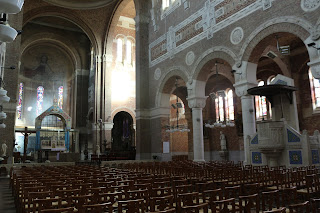Merville is a town 15 kilometres north of Bethune and about 20 kilometres south-west of Armentieres. The Communal Cemetery is on the north-east side of the town on the north side of the road to Neuf-Berquin.
Built in the 1920s, St. Peter's Church consists of two square towers surmounted by a Byzantine cap. Its dimensions make it a prominent landmark, visible at considerable distances from the town. Merville is a parish of the Roman Catholic Archdiocese of Lille. The diocesan seminary of the Lille diocese was formerly located in Merville. It is also a very large structure, built on four storeys around a central cloister, with large chapel and refectory, and accommodation for over 200 staff and students. The seminary closed in 1970 and the extensive buildings were briefly occupied by a community of religious sisters before becoming the Lille diocese's retreat and conference centre.
The main town square is dominated by the town hall, which dates from the late 1920s and is built in the Flemish Renaissance style. It incorporates a very tall clock tower. Inside, architect Louis Marie Cordonnier laid out imposing staircases, lounges of honour and beautiful stained glass windows in the colours of neighboring towns.
Merville was the scene of fighting between the Germans and French and British cavalry early in October 1914 but from the 9th of that month to 11 April 1918, it remained in Allied hands. In October 1914, and in the autumn of 1915, the town was the headquarters of the Indian Corps. It was a railhead until May 1915, and a billeting and hospital centre from 1915-1918. The 6th and Lahore Casualty Clearing Stations were there from the autumn of 1914 to the autumn of 1915; the 7th from December 1914, to April 1917; the 54th (1st/2nd London) from August 1915 to March 1918, and the 51st (Highland) from May 1917 to April 1918. On the evening of 11 April 1918, in the Battles of the Lys, the Germans forced their way into Merville and the town was not retaken until 19 August. The cemeteries were not used again until the concentration of battlefield burials into the Extension began, after the Armistice.
During the Second World War the river Lys was the southern end of a deep but narrow area held by British forces at the end of May 1940. Merville is on the territory over which were fought desperate rearguard actions during the withdrawal of the British Expeditionary Force to the coast, for evacuation from Dunkirk.
Merville Communal Cemetery was used by French troops (chiefly cavalry) in October 1914, and for Commonwealth burials from that date until August 1916 (in the case of officers, to March 1918). It now contains 1,268 Commonwealth burials of the First World War, and 12 French war graves. There is also 1 non war burial.
Merville Communal Cemetery Extension was opened in August 1916, and used by Commonwealth and Portuguese hospitals until April 1918. It was enlarged after the Armistice when graves were brought in from the battlefields immediately north and east of Merville and from the Caudescure Halte Cemetery, Morbecque. It was made by fighting units, and it contained the graves of 38 soldiers from the United Kingdom who fell in the period April-August, 1918. The Extension now contains 920 Commonwealth burials of the First World War, 345 of them unidentified. The 92 Second World War burials (18 of them unidentified) occurred mostly during the fighting in May 1940 and are interspersed among the First World War graves. The Extension also contains 19 war graves of other nationalities.
------------------------------------------------------------------------------------------------
Malcolm Guite - Lente, Lente.

































No comments:
Post a Comment